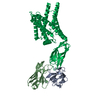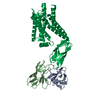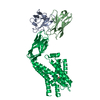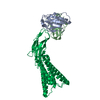[English] 日本語
 Yorodumi
Yorodumi- PDB-8dkx: Cryo-EM structure of cystinosin N288K mutant in a cytosol-open st... -
+ Open data
Open data
- Basic information
Basic information
| Entry | Database: PDB / ID: 8dkx | |||||||||
|---|---|---|---|---|---|---|---|---|---|---|
| Title | Cryo-EM structure of cystinosin N288K mutant in a cytosol-open state at pH7.5 | |||||||||
 Components Components |
| |||||||||
 Keywords Keywords |  MEMBRANE PROTEIN/Transport protein / MEMBRANE PROTEIN/Transport protein /  Cystine / Cystine /  transporter / transporter /  lysosome / lysosome /  MEMBRANE PROTEIN / MEMBRANE PROTEIN /  MEMBRANE PROTEIN-Transport protein complex MEMBRANE PROTEIN-Transport protein complex | |||||||||
| Function / homology |  Function and homology information Function and homology informationproximal tubule morphogenesis / regulation of melanin biosynthetic process / solute:proton symporter activity / L-cystine transmembrane transporter activity / positive regulation of thyroid hormone generation /  brush border assembly / renal water absorption / L-cystine transport / renal phosphate ion absorption / brush border assembly / renal water absorption / L-cystine transport / renal phosphate ion absorption /  renal glucose absorption ...proximal tubule morphogenesis / regulation of melanin biosynthetic process / solute:proton symporter activity / L-cystine transmembrane transporter activity / positive regulation of thyroid hormone generation / renal glucose absorption ...proximal tubule morphogenesis / regulation of melanin biosynthetic process / solute:proton symporter activity / L-cystine transmembrane transporter activity / positive regulation of thyroid hormone generation /  brush border assembly / renal water absorption / L-cystine transport / renal phosphate ion absorption / brush border assembly / renal water absorption / L-cystine transport / renal phosphate ion absorption /  renal glucose absorption / Transport of inorganic cations/anions and amino acids/oligopeptides / negative regulation of hydrogen peroxide biosynthetic process / Miscellaneous transport and binding events / regulation of TORC1 signaling / melanin biosynthetic process / grooming behavior / renal albumin absorption / melanosome membrane / adult walking behavior / positive regulation of mitochondrial membrane potential / lens development in camera-type eye / amino acid metabolic process / thyroid gland development / renal glucose absorption / Transport of inorganic cations/anions and amino acids/oligopeptides / negative regulation of hydrogen peroxide biosynthetic process / Miscellaneous transport and binding events / regulation of TORC1 signaling / melanin biosynthetic process / grooming behavior / renal albumin absorption / melanosome membrane / adult walking behavior / positive regulation of mitochondrial membrane potential / lens development in camera-type eye / amino acid metabolic process / thyroid gland development /  long-term memory / glutathione metabolic process / monoatomic ion transport / ATP metabolic process / positive regulation of TORC1 signaling / long-term memory / glutathione metabolic process / monoatomic ion transport / ATP metabolic process / positive regulation of TORC1 signaling /  brain development / brain development /  visual learning / transmembrane transport / visual learning / transmembrane transport /  cognition / cognition /  melanosome / melanosome /  protein transport / late endosome / protein transport / late endosome /  lysosome / lysosomal membrane / intracellular membrane-bounded organelle / negative regulation of apoptotic process / extracellular exosome / lysosome / lysosomal membrane / intracellular membrane-bounded organelle / negative regulation of apoptotic process / extracellular exosome /  plasma membrane plasma membraneSimilarity search - Function | |||||||||
| Biological species |   Mus musculus (house mouse) Mus musculus (house mouse)  Homo sapiens (human) Homo sapiens (human) | |||||||||
| Method |  ELECTRON MICROSCOPY / ELECTRON MICROSCOPY /  single particle reconstruction / single particle reconstruction /  cryo EM / Resolution: 3 Å cryo EM / Resolution: 3 Å | |||||||||
 Authors Authors | Schmiege, P. / Li, X. | |||||||||
| Funding support |  United States, 2items United States, 2items
| |||||||||
 Citation Citation |  Journal: Cell / Year: 2022 Journal: Cell / Year: 2022Title: Structure and mechanism of human cystine exporter cystinosin. Authors: Xue Guo / Philip Schmiege / Tufa E Assafa / Rong Wang / Yan Xu / Linda Donnelly / Michael Fine / Xiaodan Ni / Jiansen Jiang / Glenn Millhauser / Liang Feng / Xiaochun Li /  Abstract: Lysosomal amino acid efflux by proton-driven transporters is essential for lysosomal homeostasis, amino acid recycling, mTOR signaling, and maintaining lysosomal pH. To unravel the mechanisms of ...Lysosomal amino acid efflux by proton-driven transporters is essential for lysosomal homeostasis, amino acid recycling, mTOR signaling, and maintaining lysosomal pH. To unravel the mechanisms of these transporters, we focus on cystinosin, a prototypical lysosomal amino acid transporter that exports cystine to the cytosol, where its reduction to cysteine supplies this limiting amino acid for diverse fundamental processes and controlling nutrient adaptation. Cystinosin mutations cause cystinosis, a devastating lysosomal storage disease. Here, we present structures of human cystinosin in lumen-open, cytosol-open, and cystine-bound states, which uncover the cystine recognition mechanism and capture the key conformational states of the transport cycle. Our structures, along with functional studies and double electron-electron resonance spectroscopic investigations, reveal the molecular basis for the transporter's conformational transitions and protonation switch, show conformation-dependent Ragulator-Rag complex engagement, and demonstrate an unexpected activation mechanism. These findings provide molecular insights into lysosomal amino acid efflux and a potential therapeutic strategy. | |||||||||
| History |
|
- Structure visualization
Structure visualization
| Structure viewer | Molecule:  Molmil Molmil Jmol/JSmol Jmol/JSmol |
|---|
- Downloads & links
Downloads & links
- Download
Download
| PDBx/mmCIF format |  8dkx.cif.gz 8dkx.cif.gz | 110.9 KB | Display |  PDBx/mmCIF format PDBx/mmCIF format |
|---|---|---|---|---|
| PDB format |  pdb8dkx.ent.gz pdb8dkx.ent.gz | 83.5 KB | Display |  PDB format PDB format |
| PDBx/mmJSON format |  8dkx.json.gz 8dkx.json.gz | Tree view |  PDBx/mmJSON format PDBx/mmJSON format | |
| Others |  Other downloads Other downloads |
-Validation report
| Arichive directory |  https://data.pdbj.org/pub/pdb/validation_reports/dk/8dkx https://data.pdbj.org/pub/pdb/validation_reports/dk/8dkx ftp://data.pdbj.org/pub/pdb/validation_reports/dk/8dkx ftp://data.pdbj.org/pub/pdb/validation_reports/dk/8dkx | HTTPS FTP |
|---|
-Related structure data
| Related structure data |  27493MC  8dkeC  8dkiC  8dkmC  8dkwC  8dypC M: map data used to model this data C: citing same article ( |
|---|---|
| Similar structure data | Similarity search - Function & homology  F&H Search F&H Search |
- Links
Links
- Assembly
Assembly
| Deposited unit | 
|
|---|---|
| 1 |
|
- Components
Components
| #1: Antibody | Mass: 26768.107 Da / Num. of mol.: 1 Source method: isolated from a genetically manipulated source Source: (gene. exp.)   Mus musculus (house mouse) / Production host: Mus musculus (house mouse) / Production host:   Homo sapiens (human) Homo sapiens (human) |
|---|---|
| #2: Antibody | Mass: 25468.404 Da / Num. of mol.: 1 Source method: isolated from a genetically manipulated source Source: (gene. exp.)   Mus musculus (house mouse) / Production host: Mus musculus (house mouse) / Production host:   Homo sapiens (human) Homo sapiens (human) |
| #3: Protein | Mass: 46095.434 Da / Num. of mol.: 1 / Mutation: N288K, T260I Source method: isolated from a genetically manipulated source Source: (gene. exp.)   Homo sapiens (human) / Gene: CTNS / Production host: Homo sapiens (human) / Gene: CTNS / Production host:   Homo sapiens (human) / References: UniProt: O60931 Homo sapiens (human) / References: UniProt: O60931 |
-Experimental details
-Experiment
| Experiment | Method:  ELECTRON MICROSCOPY ELECTRON MICROSCOPY |
|---|---|
| EM experiment | Aggregation state: PARTICLE / 3D reconstruction method:  single particle reconstruction single particle reconstruction |
- Sample preparation
Sample preparation
| Component |
| ||||||||||||||||||||||||
|---|---|---|---|---|---|---|---|---|---|---|---|---|---|---|---|---|---|---|---|---|---|---|---|---|---|
| Source (natural) |
| ||||||||||||||||||||||||
| Source (recombinant) |
| ||||||||||||||||||||||||
| Buffer solution | pH: 5 | ||||||||||||||||||||||||
| Specimen | Embedding applied: NO / Shadowing applied: NO / Staining applied : NO / Vitrification applied : NO / Vitrification applied : YES : YES | ||||||||||||||||||||||||
Vitrification | Cryogen name: ETHANE |
- Electron microscopy imaging
Electron microscopy imaging
| Experimental equipment |  Model: Titan Krios / Image courtesy: FEI Company |
|---|---|
| Microscopy | Model: FEI TITAN KRIOS |
| Electron gun | Electron source : :  FIELD EMISSION GUN / Accelerating voltage: 300 kV / Illumination mode: FLOOD BEAM FIELD EMISSION GUN / Accelerating voltage: 300 kV / Illumination mode: FLOOD BEAM |
| Electron lens | Mode: BRIGHT FIELD Bright-field microscopy / Nominal defocus max: 2000 nm / Nominal defocus min: 1000 nm Bright-field microscopy / Nominal defocus max: 2000 nm / Nominal defocus min: 1000 nm |
| Image recording | Electron dose: 61.5 e/Å2 / Film or detector model: GATAN K3 (6k x 4k) |
- Processing
Processing
| Software | Name: PHENIX / Version: 1.16_3549: / Classification: refinement | ||||||||||||||||||||||||
|---|---|---|---|---|---|---|---|---|---|---|---|---|---|---|---|---|---|---|---|---|---|---|---|---|---|
CTF correction | Type: NONE | ||||||||||||||||||||||||
3D reconstruction | Resolution: 3 Å / Resolution method: FSC 0.143 CUT-OFF / Num. of particles: 323738 / Symmetry type: POINT | ||||||||||||||||||||||||
| Refine LS restraints |
|
 Movie
Movie Controller
Controller






 PDBj
PDBj


